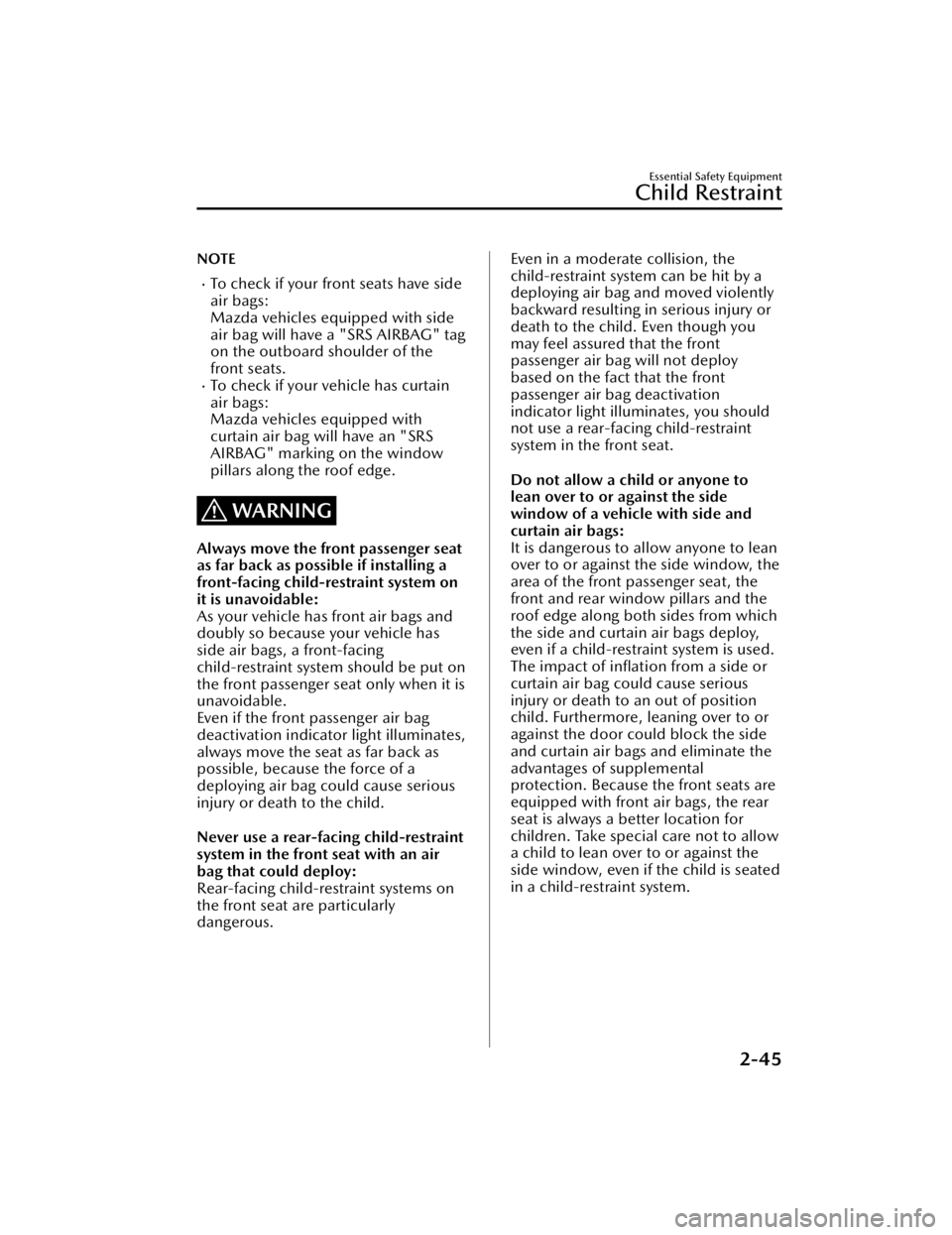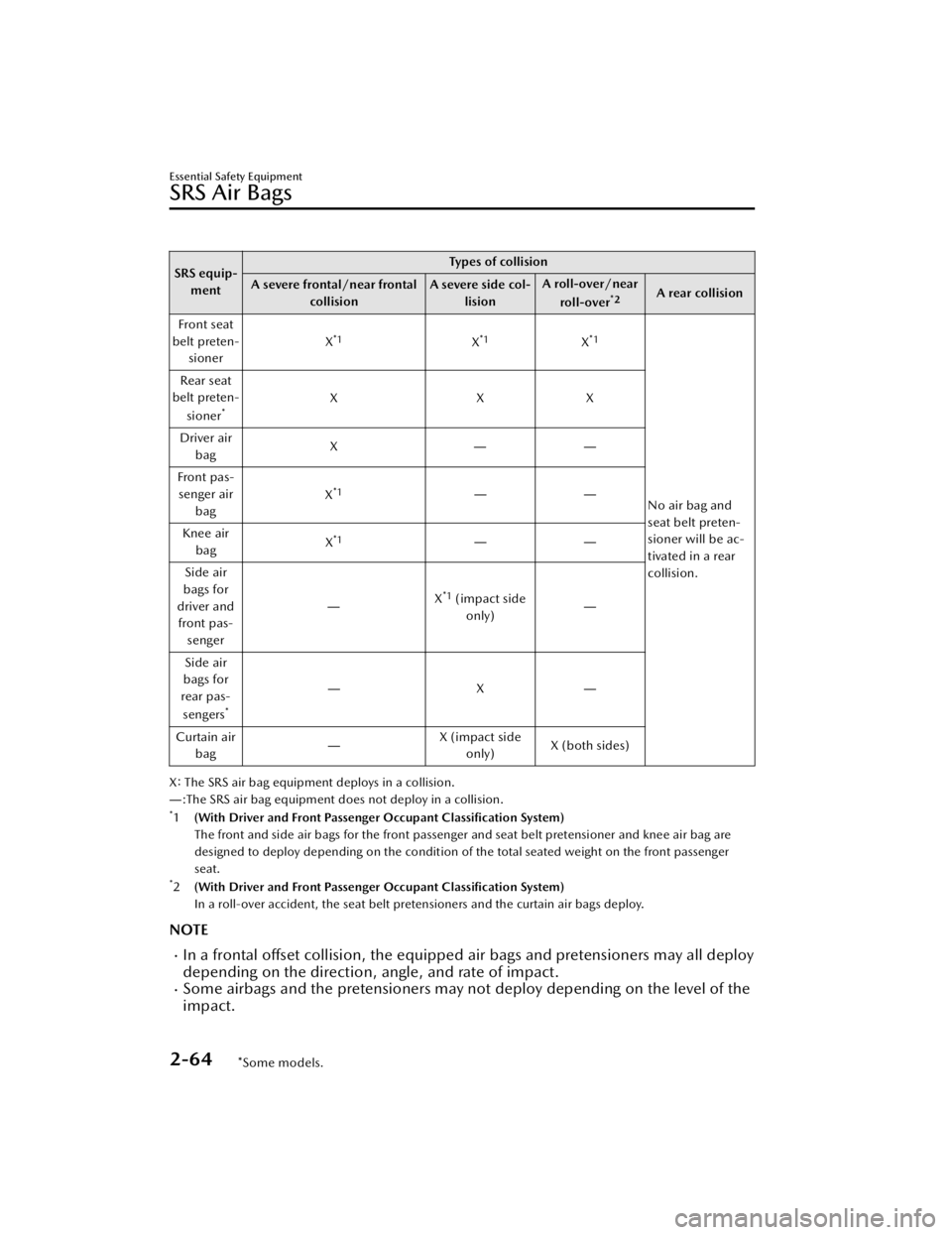airbag MAZDA MODEL CX-50 2023 Owners Manual
[x] Cancel search | Manufacturer: MAZDA, Model Year: 2023, Model line: MODEL CX-50, Model: MAZDA MODEL CX-50 2023Pages: 583, PDF Size: 85.63 MB
Page 49 of 583

WARNING
Use the correct size child-restraint
system:
For effective protection in vehicle
accidents and sudden stops, a child
must be properly restrained using a
seat belt or child-restraint system
depending on age and size. If not, the
child could be seriously injured or even
killed in an accident.
Follow the manufacturer's
instructions and always keep the
child-restraint system buckled down:
An unsecured child-restraint system is
dangerous. In a sudden stop or a
collision it could move causing serious
injury or death to the child or other
occupants. Make sure any
child-restraint system is properly
secured in place according to the
child-restraint system manufacturer's
instructions. When not in use, remove
it from the vehicle or fasten it with a
seat belt, or attach it to BOTH ISOFIX/
LATCH
*1 lower anchors for ISOFIX/
LATCH*1 child-restraint systems and
the corresponding tether anchor.
*1 ISOFIX (Mexico)/LATCH (Except Mexico)
Always secure a child in a proper
child-restraint system:
Holding a child in your arms while the
vehicle is moving is extremely
dangerous. No matter how strong the
person may be, he or she cannot hold
onto a child in a sudden stop or
collision and it could result in serious
injury or death to the child or other
occupants. Even in a moderate
accident, the child may be exposed to
air bag forces that could result in
serious injury or death to the child, or
the child may be slammed into an
adult, causing injury to both child and
adult.
Never use a rear-facing child-restraint
system in the front seat with an air
bag that could deploy:
Rear-facing child-restraint systems on
the front seat are particularly
dangerous even though you may feel
assured that a front passenger air bag
will not deploy based on the fact that
the front passenger air bag
deactivation indicator light illuminates.
The child-restraint system can be hit by
a deploying air bag and moved
violently backward resulting in serious
injury or death to the child.
(Mexico)
NEVER use a rearward facing child
restraint on a seat protected by an
ACTIVE AIRBAG in front of it, DEATH
or SERIOUS INJURY to the CHILD can
occur.
Essential Safety Equipment
Child Restraint
2-32
CX-50_8KB8-EA-22A_Edition2_new 2022-1-6 14:55:18
Page 62 of 583

NOTE
To check if your front seats have side
air bags:
Mazda vehicles equipped with side
air bag will have a "SRS AIRBAG" tag
on the outboard shoulder of the
front seats.
To check if your vehicle has curtain
air bags:
Mazda vehicles equipped with
curtain air bag will have an "SRS
AIRBAG" marking on the window
pillars along the roof edge.
WARNING
Always move the front passenger seat
as far back as possible if installing a
front-facing child-restraint system on
it is unavoidable:
As your vehicle has front air bags and
doubly so because your vehicle has
side air bags, a front-facing
child-restraint system should be put on
the front passenger seat only when it is
unavoidable.
Even if the front passenger air bag
deactivation indicator light illuminates,
always move the seat as far back as
possible, because the force of a
deploying air bag could cause serious
injury or death to the child.
Never use a rear-facing child-restraint
system in the front seat with an air
bag that could deploy:
Rear-facing child-restraint systems on
the front seat are particularly
dangerous.
Even in a moderate collision, the
child-restraint system can be hit by a
deploying air bag and moved violently
backward resulting in serious injury or
death to the child. Even though you
may feel assured that the front
passenger air bag will not deploy
based on the fact that the front
passenger air bag deactivation
indicator light illuminates, you should
not use a rear-facing child-restraint
system in the front seat.
Do not allow a child or anyone to
lean over to or against the side
window of a vehicle with side and
curtain air bags:
It is dangerous to allow anyone to lean
over to or against the side window, the
area of the front passenger seat, the
front and rear window pillars and the
roof edge along both sides from which
the side and curtain air bags deploy,
even if a child-restraint system is used.
The impact of inflation from a side or
curtain air bag could cause serious
injury or death to an out of position
child. Furthermore, leaning over to or
against the door could block the side
and curtain air bags and eliminate the
advantages of supplemental
protection. Because the front seats are
equipped with fron t air bags, the rear
seat is always a better location for
children. Take special care not to allow
a child to lean over to or against the
side window, even if the child is seated
in a child-restraint system.
Essential Safety Equipment
Child Restraint
2-45
CX-50_8KB8-EA-22A_Edition2_new 2022-1-6 14:55:18
Page 69 of 583

Supplemental Restraint
System (SRS) Precautions
▼ Supplemental Restraint System
(SRS) Precautions
The front and side supplemental
restraint systems (SRS) include
different
types of air bags. Please verify the
different types of air bags which are
equipped on your vehicle by locating
the “SRS AIRBAG” location indicators.
These indicators are visible in the area
where the air bags are installed.
The air bags are installed in the
following locations:
The steering wheel hub (driver air
bag)
The front passenger dashboard (front
passenger air bag)
Under the instrument panel (driver
and front passenger* knee air bags)The outboard sides of the front
seatbacks (side air bags for driver
and front passenger)
The outboard sides of the rear
seatbacks (side air bags for rear
passengers)
*
The front and rear window pillars,
and the roof edge along both sides
(curtain air bags)
Vehicles with the Driver and Front
Passenger Occupant Classification
System have a sensor which detects an
impending roll-over accident.
The air bag supplemental restraint
systems are designed to provide
supplemental protection in certain
situations so seat belts are always
important in the following ways:
Without seat belt usage, the air bags
cannot provide adequate protection
during an accident. Seat belt usage is
necessary to:
Keep the occupant from being
thrown into an inflating air bag.
Reduce the possibility of injuries
during an accident that is not
designed for air bag inflation, such as
rear impact.
Reduce the possibility of injuries in
frontal, near frontal or side collisions
or roll-over accidents that are not
severe enough to activate the air
bags.
Reduce the possibility of being
thrown from your vehicle.
Reduce the possibility of injuries to
lower body and legs during an
accident.
Hold the driver in a position which
allows better control of the vehicle.
If your vehicle is also equipped with a
driver and front passenger occupant
classification system, refer to the Front
Passenger Occupant Classification
System (page 2-67) for details.
If your vehicle is equipped with a driver
and front passenger occupant
classification system, the front
passenger air bag deactivation
indicator light illuminates for a
Essential Safety Equipment
SRS Air Bags
2-52*Some models.
CX-50_8KB8-EA-22A_Edition2_new 2022-1-6 14:55:18
Page 81 of 583

SRS equip-ment Types of collision
A severe frontal/near frontal collision A severe side col-
lision A roll-over/near
roll-over
*2A rear collision
Front seat
belt preten- sioner X
*1X*1X*1
No air bag and
seat belt preten-
sioner will be ac-
tivated in a rear
collision.
Rear seat
belt preten-
sioner
*XXX
Driver air bag X
――
Front pas- senger air bag X
*1――
Knee air bag X
*1――
Side air
bags for
driver and front pas- senger ―
X
*1 (impact side
only) ―
Side air
bags for
rear pas-
sengers
*
― X―
Curtain air bag ―X (impact side
only) X (both sides)
X:
The SRS air bag equipment deploys in a collision.
― :The SRS air bag equipment does not deploy in a collision.
*1 (With Driver and Front Passenger Occupant Classification System)
The front and side air bags for the front passenger and seat belt pretensioner and knee air bag are
designed to deploy depending on the condition of the total seated weight on the front passenger
seat.
*2(With Driver and Front Passenger Occupant
Classification System)
In a roll-over accident, the seat belt pretensioners and the curtain air bags deploy.
NOTE
In a frontal offset collision, the equipped air bags and pretensioners may all deploy
depending on the direction, angle, and rate of impact.
Some airbags and the pretensioners may no t deploy depending on the level of the
impact.
Essential Safety Equipment
SRS Air Bags
2-64*Some models.
CX-50_8KB8-EA-22A_Edition2_new 2022-1-6 14:55:18